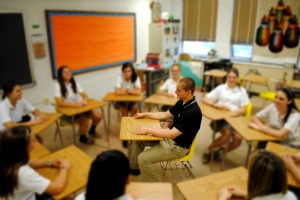When junior Amanda Weerasooriya walked into her Honors Chemistry class in the beginning of the year she thought she’d walked into the wrong classroom. There were about 15 girls and only four boys in the room. This was a high level science class, so where were all the boys?
Well, over the past few years, a new trend has begun: The girls are taking over.
At JC, 419 out of 729 students are female, this equates to 57 percent girls and 43 percent boys. However, in the majority of higher level classes, this isn’t the case.
In the English Department, the total percent of girls in honors or AP level classes is 69 percent. These classes consist of only 31 percent boys, 12 percent lower than the total number of boys in the school. The biggest difference in boys to girls in the English Department is seen in AP English 3, where only 22 percent of the class is male. The English and Social Student Departments’ advanced classes boast 40 percent more girls than boys
“It’s usually the other way around [more boys than girls] so it’s crazy how the girls outnumber the boys,” sophomore Garrett Porte said.
The gap between boys and girls in the science and math departments is much smaller. The amount of boys in higher level science and math classes is disproportionally higher than the overall amount of boys in the school. In honors and AP level science classes, boys make up 46 percent of the students, three percent above the school-wide number.
“There seems to be a growing trend amongst the boys to not succeed or challenge themselves academically. In order to get a decent job later, one needs an upper level education, minimum of a bachelor’s degree. If boys don’t wake up, they will be out of a job. By not learning how to learn, boys are short-changing their earning potential,” Science Department Chair Rebecca Jansing-Kaestner said.
“The girls just work harder than the guys,” junior Ethan Slusher said.
Some higher level classes, however, break the trend. This year’s AP Physics class contained 9 boys and only two girls.
“This is the most girls I have had in a while,” AP Physics teacher Joseph Iacchei said.
Soon Iacchei’s physics class may not be the only class to break the trend. next year’s incoming class is 51% male and 49% female. This is the fourth time in JC history that there are more boys than girls in the class.
“This year to attract male students we put an emphasis on sports, activities, and vibrant imagery. It’s all about painting a good picture. But the admissions office can only do so much. It’s also the job of the coaches, department heads, etc. to promote the school,” Director of Enrollment and Marketing Jesse Roberts said.
SAC, one of the largest clubs, consists of 74 percent girls and 26 percent boys. Boys only made up 27 percent of the cast of “Peter Pan” and “How to Succeed in Business without Really Trying.”
Academically inclined clubs such as Chemathon or Culture Shock support a larger following of girls. Chemathon consists of 67 percent girls and Culture Shock consists of 95 percent girls.
A few clubs like FCA and Yoga Club are split 50/50 for boys and girls. Clubs, like FCA and Yoga Club, that deal with athletics attract more boys than any other types of clubs.
Recently, students were given the opportunity to eat at a luncheon with new, prospective principles. Out of the 21 volunteers only four were boys, 19 percent.
“I think girls tend to want to be more involved. They see leadership positions and they take them, we do have some really driven guys in student leadership and other extracurricular activities, but with a greater female population based on the odds, girls would be more likely to be involved, sorely based on the numbers,” NHS President Allison Walczyk ’11 said.
Despite girls outnumbering boys in the school, there are 14 girls’ teams, as well as, 14 boys’ teams, and (only one co-ed team).
In sports that have both a boys’ and girls’ team, the amount of boys and girls is generally equal. For example, in soccer 43 percent of those who play are girls and 57 percent are boys. For cross country, it is the opposite. 58 percent of the runners are girls and 42 percent are boys.
This trend of dominantly girl participation isn’t only limited to JC though.
According to a Census Bureau report released April 26, 2011, women have surpassed men in receiving master’s degrees or higher. In the age group of adults 25 years and older, about 10.6 million women have master’s degrees or higher compared to about 10.5 million who have master’s degrees or higher.
“What we’re seeing at John Carroll with the young men is not just unique to John Carroll. It’s a national trend. So what does that say about my gender? What it says is that we have experienced a significant change in our society. There has been an adjustment of what it means to be a man in our society. I think the young men at John Carroll aren’t clear in their role and women are being more and more aggressive,” Vice Principal of Academics Gary Scholl said.
In the 1980s, more women began to enroll in college than men. This continues today.
“The reason why there is more girls in higher classes is because they care more about school,” sophomore Devon Ruane said.
“I think there are many smart boys at John Carroll that could be in higher level classes, but they aren’t because they just don’t apply themselves to their academics. Any boy or girl that is willing to take extra time out of his/her life and is up to the challenge of taking an above average class should jump at the chance to see if they can handle high level classes,” Weerasooriya said.
Emily Clarke is a reporter for “The Patriot” and jcpatriot.com.



